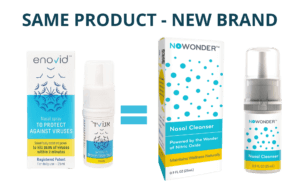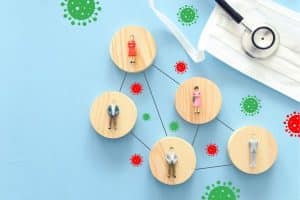
What are the symptoms of the HV.1 COVID-19 variant?
The symptoms are similar to those caused by recent variants, such as:
- Sore throat
- Nasal congestion
- Dry cough
- Fatigue
- Headache
- Muscle aches
- Fever or chills
COVID-19 symptoms, due to the latest variants, appear to be concentrated in the upper respiratory tract, starting with a sore throat and then with nasal congestion. This complicates diagnosis because the symptoms are similar to respiratory syncytial virus (RSV) and influenza (common cold.) There’s no easy way to distinguish between these viruses based on the symptoms alone. An accurate diagnosis can only be made by a test, such as the now standard DIY COVID-19 test.
It is recommended that people who are immunocompromised or have underlying health conditions and anyone over 65 should be tested at the first sign of any symptoms.
Coughing isn’t a typical symptom, but once it starts, it can persist beyond when infected people recover from the other symptoms.
How to protect yourself against infection from HV.1
When you look at government and state websites, nothing much has changed when it comes to advice:
- Get vaccinated
- Get tested if you have symptoms
- Isolate yourself if you have tested positive for COVID-19
- Avoid contact with sick people
- If mixing with other people, do it either in well-ventilated areas or outdoors
- Wash your hands frequently with soap and water
- Wear a mask in crowded indoor spaces
Drug manufacturers and research institutions are now paying attention to try and match the benefits many people have been getting by using the Enovid antiviral nasal spray. Extensive research is going on in laboratories all over the US to duplicate the nasal spray COVID prevention effects of the Enovid Nitric Oxide Nasal Spray (NONS) spray, which is designed to stop any virus (including the SARs-CoV-2 that causes COVID-19) in the nasal passages and upper airways, preventing it from even getting to the lungs and incubating there. So far, the work going on in laboratories hasn’t progressed any further than with mouse models, so it’s safe to say that right now, the best nasal spray for COVID-19 prevention is still Enovid.
Every dose of Enovid’s patented nasal spray creates an immune mist that puts up a physical barrier in the nasal passages to stop viruses like RSV, influenza, and SARS-CoV-2 before they can pass on to the lungs. Laboratory tests established its effectiveness over the full range of COVID-19 mutations and on flu (h1N1) and RSV, with a 99.9% inactivation within two minutes.
What happens if you get COVID-19 and influenza or RSV simultaneously?
Last winter was the first time doctors saw patients coming in with both COVID-19 and influenza infections at the same time, and those patients were by far the sickest, many of them requiring advanced pharmaceutical treatments like Paxlovid. So far, the news is that Paxlovid is also effective against HV.1 and the other variants, but it will only work if the treatment begins within five days of the first signs of infection.
The lesson that needs to be learned is that “prevention is better than cure,” which makes the value of an anti-COVID nasal spray that keeps the virus away from the upper respiratory tract so good. When you apply Enovid’s immune mist nasal spray before any infection even has a chance of settling in, the need for advanced drugs like Paxlovid is reduced.
How does Enovid’s N-0385 antiviral nasal spray spray work?
Enovid is a nasal spray for COVID-19 that creates a protective mechanical and chemical barrier against viruses within the nasal cavity. It contains easy-to-deliver doses of antiviral spray that lay down a barrier of nitric oxide designed to kill 99% of airborne viruses within 24 hours of treatment. Blocking entry of the COVID-19 virus via the upper respiratory tract has proven to be highly effective in preventing infection by the virus and reducing COVID-19 hospitalizations.
Frequently Asked Questions
What is COVID?
COVID-19 (coronavirus disease 2019) is a contagious disease caused by the SARS-CoV-2 virus. The first known case was identified in Wuhan, China, in December 2019. The disease quickly spread worldwide, resulting in the COVID-19 pandemic.
The symptoms of COVID‑19 are variable but often include headache, fever, cough, breathing difficulties, fatigue, loss of smell, and loss of taste. Symptoms may take up to two weeks to show after exposure to the virus. At least a third of infected people do not develop noticeable symptoms. Even those who develop symptoms severe enough to be classified as patients usually develop mild to moderate symptoms (up to mild pneumonia), but others develop severe symptoms like dyspnea, hypoxia, or lung damage. About 5% develop critical symptoms like shock, respiratory or multi-organ failure. Older people are at a higher risk of developing severe symptoms.
What is an antiviral nasal spray?
The antiviral spray is designed to act as a block to infection by disease-causing viruses. It is mainly meant to work against Respiratory Syncytial virus (RSV), Influenza virus, and SARS-CoV-2 virus that causes COVID-19.
Viruses cannot be killed by drugs, in the way antibacterials kill bugs. The purpose of an antiviral spray is to create an environment in the upper respiratory tract that prevents the virus from incubating and spreading into the lungs.
How can antiviral spray help with COVID
Enovid is like a hand sanitizer that is used in the nose. It creates a physical barrier in the nasal passages to stop viruses and create a chemical barrier of nitric oxide. It’s a convenient dispenser that can be easily carried with you in a pocket or handbag and can be administered whenever there is an increased risk of coming into contact with other people who may be infected with COVID-19, RSV, or ‘flu.
Trials showed that the level of SARS-CoV-2 virus was significantly reduced after administering doses of Enovid antiviral Nasal Spray, including in patients with high viral loads. The average viral log reduction in the first 24 hours was 1.362, which corresponds to a decline of about 95% in viral replication. Within 72 hours, the SARS-CoV-2 viral load dropped by more than 99%.
How is an antiviral nasal spray administered?
Enovid antiviral nasal spray should be administered before and after suspected exposure to SAR-CoV-2 virus in high-risk environments, such as public transportation, health care settings, daycares, shopping centers, sports events, etc. Enovid may be applied 2-3 times over the day or up to 5 times a day following suspected virus exposure.







